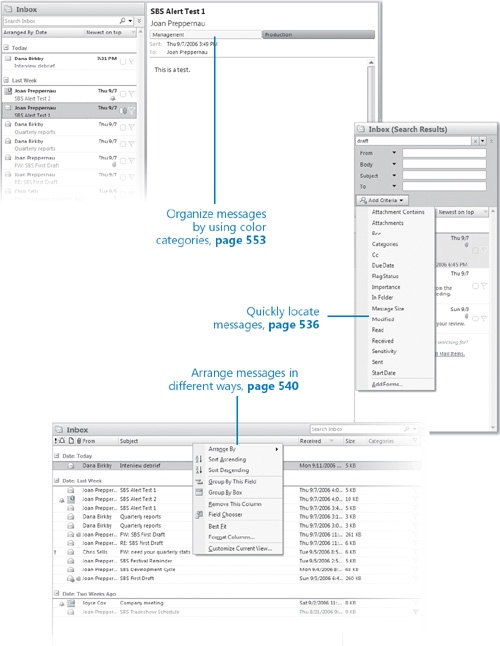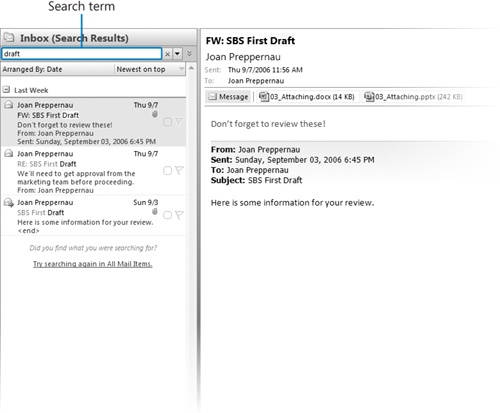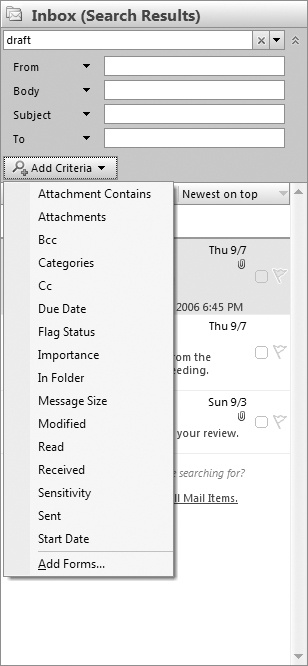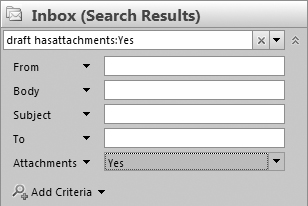In this chapter, you will learn to: | |
✓ | Quickly locate messages. |
✓ | Arrange messages in different ways. |
✓ | Organize messages by using color categories. |
✓ | Organize messages in folders. |
✓ | Archive messages. |
So far in this book, we’ve discussed the basic mechanics of sending and receiving messages, and the Outlook components used for those purposes. Now we’ll tackle the task that heavy e-mail users spend a lot of time on—managing the messages you receive. This is where Microsoft Office Outlook 2007 really stands apart from its competitors.
In addition to providing ways to organize messages in subfolders within the Inbox and to archive messages, Outlook 2007 includes a number of new features that simplify the process of managing messages and other Outlook items. The greatest of these is the new Instant Search capability, which filters messages as you type the keywords you want to search for, highlighting the search terms within each message. Another useful tool is Color Categories, which combines the named categories available in earlier versions of Outlook with colored labels to provide quick visual recognition and search capabilities.
In this chapter, you will filter and find messages by using Instant Search, display the messages in your Inbox in a variety of arrangements, and use Search Folders. Then you will organize messages by assigning color categories and by organizing them in folders within the Inbox. Finally, you will look at the default archive settings and manually archive an e-mail folder.
See Also
Do you need only a quick refresher on the topics in this chapter? See the Quick Reference entries at the beginning of this book.
Important
The exercises in this chapter require practice files created in earlier chapters; none are supplied on the book’s CD. For more information about practice files, see "Using the Book’s CD" at the beginning of this book.
Troubleshooting
Graphics and operating system–related instructions in this book reflect the Windows Vista user interface. If your computer is running Microsoft Windows XP and you experience trouble following the instructions as written, please refer to the "Information for Readers Running Windows XP" section at the beginning of this book.
Although you can use Instant Search in the Calendar, Contacts, and Tasks modules, you will most often use it to locate messages in your Inbox and other mail folders. You can search a particular mail folder or search all mail folders.
See Also
For information about mail folders, see "Organizing Messages in Folders" later in this chapter.
As you define the criteria for a search, Outlook filters out all messages that don’t match, making it easy to find exactly what you’re looking for. And here’s the neat thing: Outlook searches not only the content of the e-mail message header and the message itself, but also the content of message attachments. So if the search term you’re looking for is in a Microsoft Office Word document attached to a message, the message will be included in the search results.
Tip
You can’t instantly filter content in a Public Folder (if your organization uses these) but you can enter the search criteria and then click the Search button to get the same results as you would in your inbox.
Instant Search is based on the new Desktop Search Engine from Microsoft, which also drives the search functionality in Windows Vista. With this very powerful search engine, you can find any file on your computer containing a specified search term—whether in the file or folder name, in document or spreadsheet content, in an e-mail message within Outlook, in a message attachment, in a picture, music, or video file, and so on.. As a matter of fact, if you prefer to do so you can conduct all of your Outlook searches from the Windows Vista Start menu.
See Also
For information about Windows Vista search features, refer to Windows Vista Step by Step (ISBN 0-7356-2269-8) by Joan Preppernau and Joyce Cox (Microsoft Press, 2007).
If the search term you enter produces more than 200 results, the Search Results pane displays this information bar:
You can display all the results for the current search term by clicking the message bar, or you can narrow the results by expanding the search term or by specifying other search criteria, such as the sender, the recipient (whether the message was addressed or only copied to you), whether the message contains attachments, and so on.
In this exercise, you will use the Instant Search feature to locate a specific message in your Inbox. There are no practice files for this exercise.
Note
BE SURE TO start Outlook, display your Inbox, and display the Reading Pane before beginning this exercise.
In the Search box in the Inbox header, type one or more words likely to appear in messages in your Inbox.
As you type, Outlook filters the contents of your Inbox to display only those items containing the characters, word, or words you enter, and highlights the search term in the displayed messages.
In the lower-left corner of the program window, the status bar displays the number of messages included in the search results. The search results include only messages contained in the Inbox folder and not in any of its subfolders or any other mailbox folders.
To the right of the Search box, click the Expand the Query Builder button.
The search pane expands to include text boxes in which you can specify the sender, a term that appears in the message body, a term that appears in the message subject, or a primary recipient of the message.
In the expanded Search Results pane, click Add Criteria to display a list of additional criteria.
Selecting a field from this list adds the field to the search criteria section. Alternatively, you can click the arrow to the right of any of the default criteria and select a different field.
In the Add Criteria list, click Attachments to add that field to the search pane.
Click the Attachments arrow, and then in the list, click Yes.
Notice that your search criteria are also described in the search term box.
Outlook instantly updates the search results to display only the messages in your Inbox that contain the search term and one or more attachments.
To expand the search to include all the folders in your mailbox, at the end of the list of results shown in the Search Results pane, click Try searching again in All Mail Items.
Outlook displays the expanded search results grouped by the folder in which they appear. You can open, delete, and process a message from the Search Result pane as you would from any other. If, however, you change a message so that it no longer fits the search criteria—for instance, if you search for flagged messages and then mark the message task as complete, the message no longer appears in the Search Results pane. (It does still appear in whatever folder it is in).
Experiment with locating information by specifying criteria. When you finish, click the Clear Search button to remove the filter and redisplay the Inbox message list.





